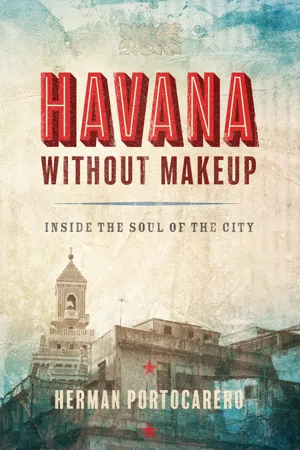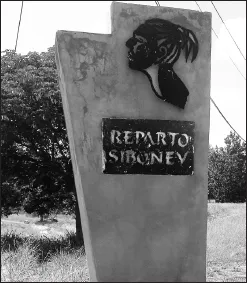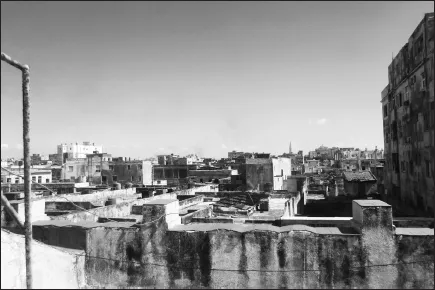![]()
1.WALLS OF ILLUSION
When Fidel Castro renounced his official functions in 2008, he settled in the outlying Havana neighborhood of Siboney, about ten miles west of the city proper. From there, he entered the last phase of a lifetime of carefully choreographed secrets about his exact movements and whereabouts. He would live in Siboney until the end in November 2016, a few months after his ninetieth birthday. Increasingly frail but lucid and intellectually active, and as opinionated as ever, he continued to see a steady trickle of foreign visitors. El Comandante kept a discreet grip on the power he had supposedly relinquished, and the environment in which he did so naturally came to the attention of the international press. It was often described as “a leafy suburb.”
Siboney signpost: rulers retire where native Cubans once found refuge.
This description reflects the frequent inability of the outside world to capture Cuban realities.
If “leafy suburb” evokes images of upper-class wealth and ease, Siboney is a far more complex neighborhood: a mixture of grandiose mansions in good and bad repair, small and medium-sized agricultural plots, patches of no-man’s land, social housing units, enclaves of privilege, and sometimes cheerful, sometimes sad anarchy. In fact, Siboney can be seen as a microcosm of Cuba as a whole. But Havana as a city is even more complex.
Built on deep contradictions, the Cuban capital has become a place like no other. In the first half of the twentieth century, it was a center of elegance and political violence, of commercially exploited sensuality and endemic corruption. But at the same time, it was a thriving and multifaceted society, albeit a socially divided one. The Cuban Revolution put this small country on the world map as never before, as a focal point of slogans and fiery speeches enforcing equality and conformism as a price to pay for national unity and independence from the United States. Half a century later, these stages through which it has passed have molded and scarred the city in a unique way, leaving it suspended between dreams and results of extreme utopia and the reality of sometimes extreme neglect. There are peculiar connections between the people of Havana and the walls between which they live.
Havana may be the most sensual ruin on the planet. Much like New Yorkers outdoors in summer, the people of this city wear the buildings like flesh, but in Havana the border between flesh and stone is much more blurred. And yet, at times, the city also exudes an overwhelming melancholy, never better expressed than by the Cuban singer-songwriter Carlos Varela.
In his song “Habáname,” he sings about how painful it is to see every wall in the city he loves deeply crumble. This refers not just to physical decay but also to the aging slogans on the walls. This peculiar song, with all the weight of personal experience it carries, never fails to move me to tears; but then, at every street corner of this Havana of the end of illusions, I am seized by the raw and youthful energy of the city, and pulled into its currents and undertows. I will add my voice to Carlos Varela’s, to state that everything I say about Havana will be inspired by love and by respect, even when I disagree with her sometimes, as an honest lover should.
It’s the mixture of extreme melancholy and energy that best defines Havana.
Large sections of the city are elegant ruins. For the purpose of tourism and the preservation of historical heritage, parts of Habana Vieja – the colonial city – have been and are still being beautifully restored. Much respect is due to city historian Eusebio Leal, who has overseen this restoration since the 1980s, masterfully blending history with the present, and who has skillfully avoided turning the old city into a sterile theme park, maintaining a living city while catering to the demands and expectations of foreign visitors. No place on earth has been more soulfully preserved and brought back to life than Habana Vieja.
But follow me now into some ordinary outlying neighborhoods, cutting through the decidedly un-touristy barrios of Centro Habana, Diez de Octubre, Luyano, La Víbora, Lacret, Lawton, Santos Suárez . . . Everywhere, even in the remote suburbs, you will see the same once-grand buildings with their galleries and sculptured terraces, transformed into improvised multifamily dwellings of often astonishing complexity, lived in by the liveliest and most quick-eyed of inhabitants, ready to seize the moment and the fleeting happiness of music and a bottle of rum, alongside the philosophical beggar and the staunch communist unwilling to concede defeat.
In the run-down neighborhoods you become immersed in a lazy sensuality impossible to recapture elsewhere, since both the setting and the spirit of the inhabitants are so unique. Perhaps there is no future here, but this only adds to its seduction. And the strangest paradox of all is that the overregulated life of communism has resulted in this sensual labyrinth of flesh and stone, a final proof that human beings will not be regimented, and that perseverance and inventiveness will prevail, infusing every ruin touched by bare feet and lazy arms with sweat and soul.
But the paradox runs even deeper, for most Cubans are happily unaware of how unique their world and their city are. As a saying goes: El pez no sabe del agua (The fish is unaware of the water).
Next to buildings, cars have become the most obvious Cuban icons. The average Cuban 1959 Chevrolet – called almendrones (“big almonds”) – now often runs on improvised carburetors and engine blocs partly filled up with lead to close off excessively hungry cylinders. Not to mention the often exuberantly refurbished interiors. Many of these cars, mostly parked around the Capitolio and in front of the Gran Teatro, have now been converted into tourist attractions, but in their original run-down versions most still serve as collective taxis, plying routes at affordable fares for the people of Havana.
As a foreigner your hour-long ride in a shiny convertible almendrón will cost you the equivalent of an average monthly salary for a Cuban citizen. Only a few hundred yards away, a woman is getting into a much rougher car of the same make and year in the busy parking lot behind the Parque de la Fraternidad, where improvised dispatchers help her find a 10 peso ride to her remote home in the suburbs of La Lisa, Lawton, Diez de Octubre or Santos Suarez. The cars fill up with passengers packed together in forced intimacy taken mostly with humor and as an occasion to exchange gossip, and set off with a rattling clutch in a cloud of exhaust fumes.
Immersed in Havana, you tend to take her for granted in her frozen time, her langourous sensuality, and the complicated procedures of her daily life. You wish or hope for improvements, not realizing that such changes might subvert much of what makes her so special.
The Walls of Illusion still bear the slogans of defiance: “¡En Cada Barrio Revolución! Aquí no se rinde nadie” (“Revolution in every neighborhood! Here nobody surrenders”). This thick layer of revolutionary makeup no longer hides the aging skin underneath.
But the ultimate symbol of its kind is the seaside Malecón wall, the last rampart of the Cold War, a frontier between two worlds. It exerts a magical attraction. You sit on it, watching the ocean, and become part of the history of the world. Over this very stretch of sea passed the gold and silver of the Spanish empire, the slave ships from Calabar and the West African coast on their way to the Mississippi, and the trade between Asia and Europe long before the Panama Canal existed. In the 1960s, when the world risked nuclear annihilation, this wall stood right in the middle.
![]()
2.EXCEPTIONAL
It’s not easy to define one’s loyalties when it comes to Cuba, especially when one has had a long and intricate relationship with the country and its people. One might begin with a simple and abstract idea, such as “I wish the best possible future for Cuba.” But the sentiment becomes complicated almost immediately.
Over more than half a century, so much of the country’s personality has been built up in sheer opposition to the United States that the main question becomes: How will that personality survive in the long run, once that opposition is removed? How will Cuba define herself once freed from that contradiction?
Many societies throughout history have defined themselves in opposition to an outside enemy. It’s one of the oldest political games on the planet.
But Cuba’s case is extreme: a small island state has built an iconic image for itself, and had a global impact on the collective imagination, by opposing the superpower next door. For an apt comparison in ancient history, we might imagine a bold Sicily resisting and taunting a Roman Empire unable to subdue it.
Cuban exceptionalism – the belief in the uniqueness of the island – has some justification in history. Cuba developed differently from other Spanish colonies. Its struggle for independence came much later than in the rest of Latin America, and took a different form. Nor did it share much history with the other Caribbean islands. Slavery was different here, and Cuba was more mixed and diverse than the other islands; it was always a global crossroads and an outward-looking society. Though conditions were harsh for many or most, it was also characterized by a pursuit of pleasure. Early on, its beliefs became a mixture of the European and the African. Havana always lived on the quick wits of its inhabitants as much as on the gold of traders and speculators.
The communist dogmatism imposed by Fidel’s unyielding personality had nothing in common with Havana’s opportunism as a port city, absorbing languages, attitudes, and fashions with the ease of a wild child roaming the quaysides and gladly dancing and sleeping with the enemy, as the city had done during the brief British occupation of 1762. Even today the Castros – second generation immigrants in Cuba – define themselves as stubborn gallegos, sons of the hard-working, no-nonsense northern Spanish region of Galicia.
Heroism, subversion and seduction became shared national traits of the new Cuba, however mutually contradictory. Centuries of day-to-day survival skills were honed to a fine art during years of penury, as became obvious in the 1990s when the collapse of the Soviet Union, Cuba’s then near-exclusive economic and political partner, plunged the island into a deep economic crisis.
One can’t help but wonder how all those contradictions will play out in the future.
![]()
3.NOCTURNES (HAVANA BY NIGHT)
By day the city’s walls become the very flesh of habaneras and habaneros. Past midnight, the flesh becomes palpable shadow. Follow me now through Centro Habana, along Belascoaín to Cuatro Caminos, and from there, along Calzada del Cerro and Monte towards the Belle Epoque city center around the Capitolio. The sidewalks look mostly deserted, with a game of dominos in progress here and there. Some furtive passersby on foot or on a squeaky bicycle are carrying modest bundles of contraband.
The dilapidated buildings with their columns and balconies, which by day still display traces of their former elegance, now look more menacing. They transform into a city besieged and half-bombarded, survivors scrambling through secret passages. The buildings in this neighborhood, like in many others, have turned organic. The result of neglect and improvisation, their stately architecture has gradually melted into a maze of mysteriously connected hideouts. Beneath the high ceilings of the former palaces, many rooms have been horizontally subdivided to create extra spaces, lofts known as barbacoas often accessible only through gymnastic contortions. The narrow shelters many habaneros in poor neighborhoods call home are reflected in the name of the fashionable restaurant La Guarida in Calle Concordia in Centro Habana. The name, taken from the movie Fresa y chocolate (1994), means something like “the foxhole.”
Reality check: Centro Habana from Calle San Lázaro rooftop
Another Cuban movie, Juan de los Muertos (2012), poked grotesque fun at the psychological consequences of tired revolutions by turning the entire population of Havana into zombies. There was no need to build sets: the city provided the perfect environment for the undead to roam, and for survivors to seek refuge from mutants in their foxholes.
Along Calzada del Cerro, under a full moon, deep shadows carve out contrasts of dramatic detail against fantastic skies, with here and there an incongruous royal palm tree emerging out of a hidden garden, towering over rooftops crisscrossed with generations of improvised plumbing and wiring. These snakelike skeins look just as jungle-like as the roots that hug and penetrate walls and columns in acts of slow motion copulation with the mansions of the “leafy suburbs.”
The mysteries deepen in the narrower streets. A lone smoker sitting on his doorstep converses with street cats and dogs, thriving in a miasma of noxious gasoline, burned and spat out as hallucinogenic fumes by 1950s Chevrolets that are packed at night with chulos and chulas, some of them proudly proclaiming by way of bumper stickers: Soy el 13 de más 12, in the code of the bolita, or street lottery, I’m the pimp with the most whores.
Abandoned nineteenth-century trains slowly rust away in the Cristina station at Cuatro Caminos – industrial dinosaurs without a museum. One wonders when those ghost trains last entered the station, what voyages ended here. The older barrios south of the Avenida del Puerto lie beneath the grandiose Mad Max architecture of the ancient Tallapiedra power station. Here, life becomes teeming again, with animated domino games in progress, and quick eyes on the lookout for intruders.
During the hot summer nights, life increasingly spills out onto the streets. Kids run around sidewalk craters displaying sewer systems gone geological with age. Among their elders, sudden, vicious quarrels erupt about sex or territoriality, fueled by too much rum or other less benign substances.
In these parts of Habana Vieja, a world removed from the tourist streets, here and there semi-collapsed buildings have become half-open spaces and floating floors become grottoes, some of them still inhabited. On the ground floors, deep corridors leading to successive mysterious patios have likewise become objects of speleology rather than o...


